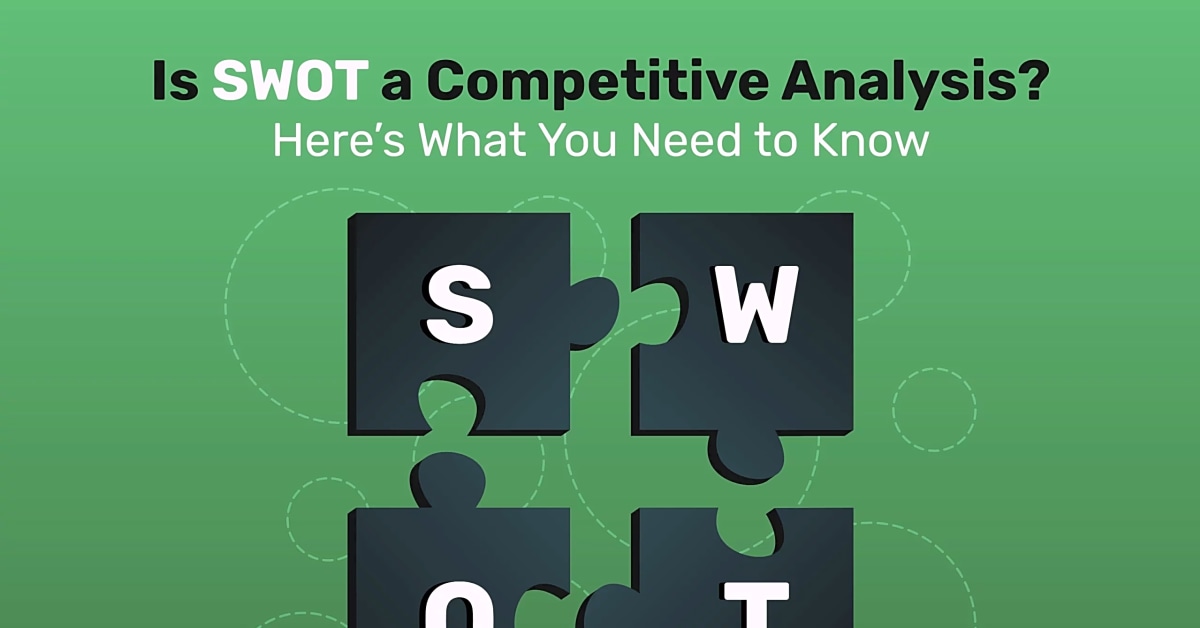In today’s competitive business landscape, it is crucial for companies to have a thorough understanding of their strengths, weaknesses, opportunities, and threats. This is where SWOT analysis comes in. SWOT stands for Strengths, Weaknesses, Opportunities, and Threats, and it is a popular strategic planning tool used by businesses to evaluate their position in the market. By analyzing these four factors, companies can gain valuable insights into their current standing and make informed decisions for the future. In this article, we will explore the advantages of using SWOT analysis for competitive analysis and how it can help businesses stay ahead of the game. So let’s dive in and see how this powerful tool can help you gain a competitive edge in your industry.
SWOT analysis is a strategic planning tool that can provide valuable insights for businesses and individuals alike. It stands for strengths, weaknesses, opportunities, and threats, and is used to evaluate the current and future potential of a company or project. By identifying and analyzing these four components, organizations can make informed decisions and gain a competitive advantage.
Firstly, let’s define what each component of a SWOT analysis means. Strengths refer to the internal factors that give a company an edge over its competitors. This could include resources, expertise, or unique selling points. On the other hand, weaknesses are internal factors that hinder an organization’s success. These could be lack of resources, poor marketing strategies, or outdated technology.
Opportunities are external factors that have the potential to benefit a company. This could include new markets, advancements in technology, or changing consumer preferences. Finally, threats are external factors that could negatively impact an organization. These could include competition, economic downturns, or political changes.
Now that we have a better understanding of each component, let’s look at how they can be identified and used to gain a competitive advantage. One way to identify strengths and weaknesses is by conducting a SWOT analysis survey with employees and stakeholders. This can provide valuable insights and perspectives on the organization’s internal operations.
Opportunities and threats can be identified through market research, competitor analysis, and staying updated on industry trends. By understanding these external factors, organizations can adapt their strategies to capitalize on opportunities and mitigate potential threats.
When conducting a SWOT analysis, it’s important to avoid common mistakes such as being overly optimistic or pessimistic, not involving key stakeholders, or not considering all four components equally. It’s also essential to regularly revisit and update the analysis as the business landscape is constantly evolving.
Fortunately, there are various templates and tools available to assist with organizing and conducting a SWOT analysis. These range from simple SWOT grids to more advanced software programs that allow for customization and collaboration. By using these resources, organizations can ensure a comprehensive and efficient analysis.
Lastly, SWOT analysis can be applied beyond business purposes. Individuals can use it for personal development by identifying their strengths and weaknesses and setting goals to capitalize on opportunities and overcome threats. It can also be used for decision-making in areas such as career planning or project management.
Templates and Tools for SWOT Analysis
When it comes to conducting a successful SWOT analysis, having the right tools and resources can make all the difference. Fortunately, there are various templates and software available that can assist you in organizing and conducting your analysis with ease.
One popular resource is the SWOT matrix template, which provides a clear and organized format for identifying and evaluating internal strengths and weaknesses, as well as external opportunities and threats. This template can be easily customized to fit your specific business or personal needs.
Additionally, there are many SWOT analysis software programs available that can streamline the process and provide valuable insights and data. These tools often include features such as data visualization, collaboration capabilities, and customizable templates.
No matter what your specific needs may be, there is a wide range of templates and tools available to help you conduct a comprehensive and effective SWOT analysis. By utilizing these resources, you can ensure that your analysis is thorough, organized, and ultimately leads to strategic planning for competitive advantage.
Beyond Business: Other Uses for SWOT Analysis
In addition to its practical application in business and strategic planning, SWOT analysis can also be a valuable tool for personal development and decision-making. By analyzing your own strengths, weaknesses, opportunities, and threats, you can gain a better understanding of yourself and make more informed decisions about your future.
Personal Development: SWOT analysis can be used as a self-assessment tool to identify areas where you excel and areas where you may need to improve. By gaining a clear understanding of your strengths and weaknesses, you can focus on developing skills and improving yourself to reach your full potential.
Decision-Making: Whether you are facing a major life decision or a small everyday choice, using SWOT analysis can help you weigh the pros and cons and make a more informed decision. By identifying potential opportunities and threats, you can consider all aspects before making a choice.
What is a SWOT Analysis?
SWOT analysis is a strategic planning tool that is used to identify and evaluate the strengths, weaknesses, opportunities, and threats of an organization or individual. It provides a comprehensive overview of the internal and external factors that can impact the success or failure of a business or personal endeavor.
Strengths refer to the positive attributes or resources that an entity possesses, such as a strong brand reputation, skilled workforce, or advanced technology. Weaknesses are areas that need improvement or pose challenges, such as limited financial resources or lack of market knowledge.
Opportunities are external factors that can be leveraged to achieve success, such as emerging markets or changing consumer trends. Threats, on the other hand, are external factors that can hinder progress, such as increased competition or economic downturns.
Importance in Strategic Planning
SWOT analysis allows organizations and individuals to identify their competitive advantages and disadvantages, as well as potential opportunities and threats in their environment. This information can then be used to develop strategies and make informed decisions that align with their goals and objectives. It also enables them to anticipate potential challenges and mitigate risks.
Conducting a Successful SWOT Analysis
A SWOT analysis is a powerful tool that allows you to assess your strengths, weaknesses, opportunities, and threats. It provides a structured framework for evaluating your current situation and identifying areas for improvement. In this section, we will discuss some tips and examples to help you conduct a successful SWOT analysis.
Firstly, it is important to be objective when identifying your strengths and weaknesses. This means being honest about your capabilities and not downplaying or exaggerating them. You can also gather feedback from others to gain a more well-rounded perspective.
When looking at opportunities and threats, it is important to consider both internal and external factors. Internal opportunities and threats can include things like your company’s resources or current market position, while external opportunities and threats can include factors like changes in the economy or new competitors entering the market.
One helpful way to identify these factors is by using the SWOT analysis matrix, which divides your analysis into four quadrants: strengths, weaknesses, opportunities, and threats. This visual representation can make it easier to see where each factor falls and how they may relate to each other.
Additionally, using templates or examples can provide you with a starting point for your analysis. There are many resources available online that offer pre-made SWOT analysis templates or case studies that showcase how companies have used SWOT analysis to their advantage.
Overall, conducting a successful SWOT analysis requires a combination of objectivity, thoroughness, and the use of helpful tools. By following these tips and using examples as a guide, you can effectively identify your strengths, weaknesses, opportunities, and threats in your SWOT analysis.
Avoiding Common Mistakes
When conducting a SWOT analysis, it is important to avoid common mistakes that can affect the accuracy and effectiveness of your results. These mistakes can lead to misleading information and hinder the overall success of your competitive analysis. In this section, we will discuss the most common mistakes to watch out for when conducting a SWOT analysis.
1. Not Conducting a Thorough Analysis:
One of the biggest mistakes that people make when conducting a SWOT analysis is not taking the time to thoroughly analyze each category. It is important to gather as much information as possible and look at both internal and external factors that can impact your business. Skipping over important details can lead to an incomplete and inaccurate analysis.
2. Bias or Lack of Objectivity:
Another common mistake is allowing personal biases or opinions to influence the analysis. It is important to approach the analysis with an open mind and gather information from various sources. This will ensure that your analysis is unbiased and reflects the true state of your business.
3. Focusing on Only One Area:
When conducting a SWOT analysis, it is easy to focus on only one area, such as strengths or opportunities, while neglecting other areas. This can lead to an unbalanced analysis and overlook potential threats or weaknesses that may exist. It is important to give equal attention to all four categories for a comprehensive analysis.
4. Not Updating the Analysis:
A SWOT analysis should be an ongoing process that is regularly updated as your business and industry evolves. Many people make the mistake of conducting a SWOT analysis once and then never revisiting it. This can lead to outdated information and hinder decision-making. It is important to regularly review and update your analysis to ensure its accuracy.
By avoiding these common mistakes, you can ensure that your SWOT analysis is accurate and effective in providing valuable insights for your competitive analysis.
By now, you should have a thorough understanding of SWOT analysis and its benefits for competitive analysis. Whether you are a business owner, student, or individual looking to make strategic decisions, utilizing SWOT analysis can help you gain a competitive advantage. Remember to use the four components of SWOT analysis together to get a comprehensive understanding of your current situation and identify areas for improvement. With the help of templates and tools, conducting a successful SWOT analysis can be made easier. So why wait? Start using SWOT analysis today!


